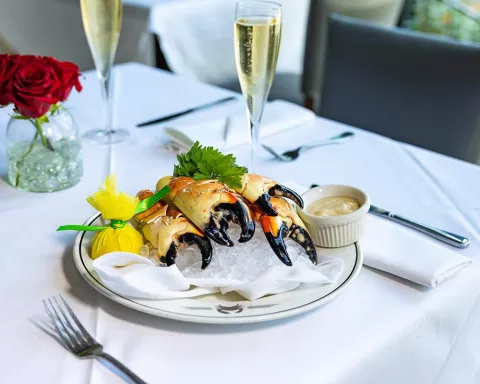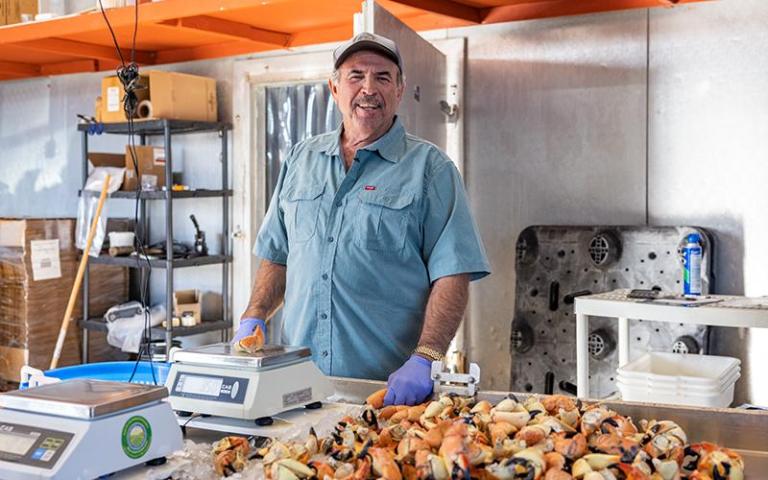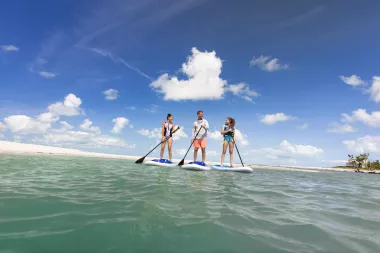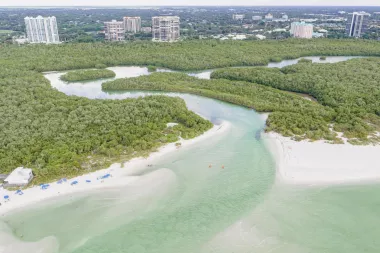Stone Crab Claws: The Sustainable Delicacy Of Florida’s Paradise Coast

Most visitors to Florida’s Paradise Coast who are fortunate enough to eat stone crab claws know at least one thing about our local delicacy: Stone crab claws are delicious.
What they often don’t know is this: Stone crabs are not trapped and eaten like most crabs. A single claw is removed and the crab is returned to the water, where they regenerate new claws.

“Stone crab claws are renewable, sustainable,” says Kelly Kirk of Kirk Fish Company in Goodland, a small town 25 miles southeast of Naples. “We want to make sure that stone crabs are a viable and sustainable resource for decades to come.”
A key regulation furthers the sustainability of stone crab. They can only be caught, processed and served during a specific season, October 15 to May 1. The fact that those six-and-half months line up perfectly with the Paradise Coast’s primary tourism season makes it all the better.
Kelly Kirk is a fifth-generation member of a fishing family that has long focused on stone crab. In fact, the Kirks had a hand in naming Goodland. “The town was created in the late 1940s,” Kelly says. “[My family] moved over from Caxambas when they approached my grandparents and said, ‘There's a piece of good land we want you to move to. We'll sell it to you really cheap and we'll kind of set you up in that area, and it's a good piece of land.’”
Hence, the place was christened Goodland.
Kelly spent a good portion of her youth on the Kirk Fish Company dock, helping out her parents, fishing, or simply reading a book. But Kelly wasn’t sure she wanted to stay in a tiny town and join the family business.
“I wanted to be a doctor,” she says. “When I went to college, I had to get away. I had to go to college to learn that this is exactly where I was supposed to be all along. There was no better place for me than the dock that I grew up on right here, working with my family. And now my husband is part of it and we're continuing it on for as many generations as we can.”
It’s widely believed that the commercial stone crab industry began in Everglades City, which is just a 25-mile drive from Goodland, probably in the late 1800s. “Stone-crabbing happened by accident because the original market was for blue crab,” says Thomas Lockyear, manager of the Museum of the Everglades in Everglades City. “Stone crab was an annoyance. It was taking up space in your blue crab trap.”
Theories abound about how and why the local crabbers switched to a different crustacean. None are absolute. “But it really doesn’t matter at the end of the day,” Lockyear says. “How did it evolve? It evolved from trial and error.”
Kelly Kirk, who is one of three women who formed the Florida Stone Crabber’s Association in 2020, says there are some seasons where Everglades City and Goodland produce up to 40% of the stone crabs in Florida.
The industry is very much the domain of a few small operators, most of whom use their own boats and crews to catch the crabs. After long, hard days, the crabbers bring their catch back to the dock.

Grimm’s Stone Crab is one such business. It’s owned by Howie Grimm, [NOTE: LINK TO INTERVIEW WITH GRIMM WHEN POSTED] who is also the mayor of Everglades City. He explains what happens immediately after the crabs are hauled from the dock. A few employees remove the claws, then, “We cook up to 400 pounds at a time for about eight minutes at around 180 degrees,” he says. “Then we put them in a second tank that cools them.”
Stone crab businesses sort the claws by size. At Kirk Fish Company, “we grade out medium, large, jumbo and colossal,” Kelly says. “We have a rule as far as how big they must weigh to qualify for each size.”
A primary focus of Kelly’s efforts with the Florida Stone Crabber’s Association is to ensure the longevity of the area’s heritage business. “We've all worked really hard to unite the industry and make sure that both the stone crab is represented and the stone crabber is represented,” she says. “And we also want to make sure that we're bridging the gap between management, the biology, and the actual fishermen.”
She’s optimistic about the seafood’s future. “It’s such a family oriented industry,” she says. “There’s always kids around. There’s always the next generation watching. We have to encourage them to come into the industry and set them up for success.”
And then Kelly emphasizes a key point: “There’s no farm-raised stone crab. And there never will be.”
A certain amount of the claws produced on Florida’s Paradise Coast are sent to places far and wide. Grimm’s Stone Crab, for one, does a robust shipping business.
“People get them in other parts of the country, freeze them and eat them that way,” Kelly says. “But there’s nothing like fresh off the dock — that day’s product ready to eat right then.”
Click here for more on stone crab claws, including where and how to eat them, and some fun facts
Explore More of Paradise Coast

Guide to Family Gatherings in Naples, Marco Island and the Everglades

Find Your Beach in Naples and Marco Island

Explore Natural Beauty at Keeywadin Island
